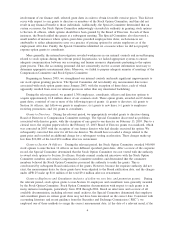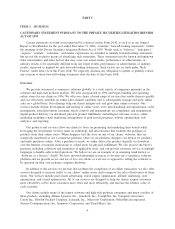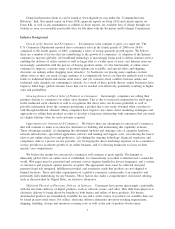Digital River 2006 Annual Report Download - page 18
Download and view the complete annual report
Please find page 18 of the 2006 Digital River annual report below. You can navigate through the pages in the report by either clicking on the pages listed below, or by using the keyword search tool below to find specific information within the annual report.All data centers currently utilize multiple levels of redundant systems, including load balancers managing
traffic volumes across web and application server farms, database servers, and enterprise disk storage
arrays. For the majority of these systems, we have automatic failover procedures in place such that when
a fault is detected, a process automatically takes that portion of the system offline and processing
continues on the remaining redundant portions of the system, or in an alternate datacenter. In the event of
an electrical power failure, we have redundant power generators and uninterruptible power supplies that
protect our facilities. Fire suppression systems are present in each data center.
Our network software constantly monitors our clients’ e-commerce sites and internal system functions,
and notifies systems engineers if any unexpected conditions arise. We lease multiple lines from diverse
Internet service providers and maintain a policy of adding additional capacity if more than 40 percent of
our capacity is consistently utilized. Accordingly, if one line fails, the other lines are able to assume the
traffic load of the failed line. We also utilize content distribution networks operated by our vendors to
serve appropriate types of traffic; currently, the majority of our image traffic and a substantial portion of
our download traffic is served via the Akamai, Limelight and Mirror Image networks.
Product Research and Development
Our primary product research and development strategy is to continually enhance the technology and
feature set of our commerce platforms and related technologies. To this end, we continually have numerous
development projects in process, including ongoing enhancement of our commerce platforms, improvements in
our remote control capabilities, enhanced international support, advanced product distribution capabilities, and
new marketing technologies. Product research and development expenses were $32.3 million, $20.7 million,
and $14.3 million, in 2006, 2005, and 2004 respectively.
We believe that the functionality and capabilities of our commerce platforms are a competitive advantage
and that we must continue to invest in them to maintain our competitive position. The Internet and
e-commerce, in particular, are subject to rapid technological change, changes in user and client requirements
and expectations, new technologies and evolving industry standards. To remain successful, we must continually
adapt to these and other changes. We rely on internally developed, acquired and licensed technologies to
maintain the technological sufficiency of our commerce platforms.
Competition
The market for e-commerce solutions is highly competitive. We compete with e-commerce solutions that
our customers develop themselves or contract with third parties to develop. We also compete with other
outsourced e-commerce providers. The competition we encounter includes:
• In-house development of e-commerce capabilities using tools or applications from companies such as
Art Technology Group, Inc. and IBM Corporation;
• E-Commerce capabilities custom-developed by companies such as IBM Global Services, and Accenture,
Inc.;
• Other providers of outsourced e-commerce solutions, such as GSI Commerce, Inc., Macrovision
Corporation, and asknet Inc;
• Providers of technologies, services or products that support a portion of the e-commerce process, such
as payment processing, including CyberSource Corporation and PayPal Corp.;
• Companies that offer various online marketing services, technologies and products, including Value-
Click, Inc. and aQuantive, Inc.;
• High-traffic branded websites that generate a substantial portion of their revenue from e-commerce and
may offer or provide to others the means to offer products for sale, such as Amazon.com, Inc.; and
14
























